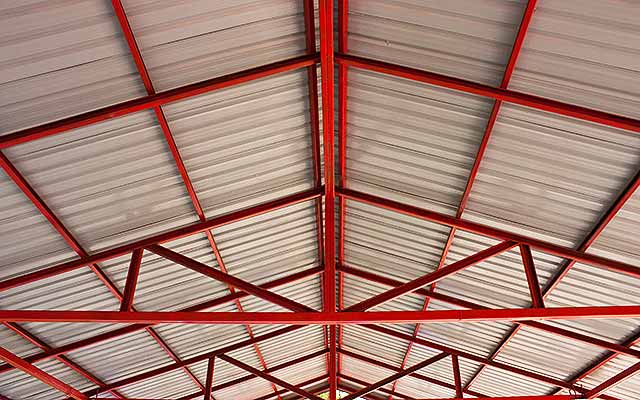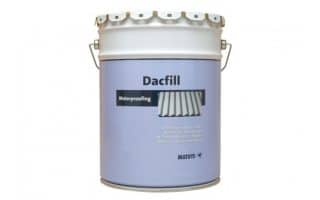We recently received a telephone enquiry from a leading industrial paint spraying company requiring an asbestos encapsulation paint system. This was in connection with coating the underside of a corrugated fibrous cement roof panel. The roof panel had been constructed from a asbestos product named Asbestolux. There was not an Artex ceiling below the corrugated roof sheeting, hence the need for asbestos encapsulation system.
Introducing The Project
The panels were on a large industrial unit that had been purchased by a high end luxury sports car distributor in West London.
The contractors client was intending to use the unit as a service department for their vehicles. The client wanted the complete envelope of the building to portray the smart slick image of the Italian high performance car company brand.
Specification of Asbestos Encapsulation
Further to a close inspection, it was established that the roof panels were in generally good condition. They were showing only 1 or 2 signs of splitting. The surface showed no signs of de-laminating, although there was a degree of surface contamination from vehicle fumes and general airborne pollution.

Introducing Rust-Oleum Dacfill
 For the exterior of the roof, the best asbestos encapsulation paint recommended by Promain’s technical team is Rust-Oleum Dacfill. This project has extensive tests and specifications to protect the owners and public from the materials degradation.
For the exterior of the roof, the best asbestos encapsulation paint recommended by Promain’s technical team is Rust-Oleum Dacfill. This project has extensive tests and specifications to protect the owners and public from the materials degradation.
Dacfill is a water based, 400% elastomeric, micro-porous paint that is approved for coating and encapsulating asbestos roof sheets.
However, it was decided that rather than coating the complete outside surface of the roof with Dacfill, the splits would be repaired from the outside using a strip of Acrypol woven bandage and Rustoleum Fillcoat. This system would create a long term, instant but strong, yet flexible repair to the asbestos roofing sheets.
The underside of the roof was cleaned with a dilute solution of Rust-Oleum Cleaner & Degreaser ND14. ND14 is a alkaline cleaning solution that leaves the surface perfect for painting. This was allowed to dry overnight before 2 coats of Classidur Aquasil tinted to RAL 7004 was applied by airless spray.
Introducing Classidur Aquasil
Classidur Aquasil Mat is a water based, zero tension and non film forming paint coating that offers ease of application directly to new plaster and plasterboard, as well as excellent water resistance for an easily cleaned surface.
This is a high quality paint for asbestos that has been designed specifically for application to walls or ceilings found internally for a white matt finish that will not yellow when exposed to natural light.
This system proved to be an extremely financially economic solution. The asbestos encapsulation system offers amazing adhesion, and excellent covering power. With added ease of application, the system left the surface a uniform colour with very little effort.
The client and contractor were both delighted with the results achieved and by the advice provided by Promain. They then asked the Technical Department to produce further specifications for the walls and floor.
What is Asbestolux?
Asbestolux was the trade name behind Cape Asbestos, a manufacturer of asbestos insulation boards, they produced the product, Asbestolux, between 1951 and 1980. They were known for manufacturing asbestos boards, popular options for asbestos boards and roofing sheets which were used for roofing, panelling, internal partitions, soffits, ceiling tiles and behind heaters. The asbestos insulation boards, also known as Asbestolux and AIB, included significant amounts of asbestos, between 16% and 35%, asbestos was usually amosite and chrysotile, however some boards were crocidolite. Asbestolux boards were also known for being used for fire protection as they had good fire resistance qualities. As well as the undersides of stairs to prevent fires from spreading from one floor to the next, as well as doors.
Asbestolux tends to be used for all forms of insulation purposes, this includes panelling and internal partitions, soffits, in the back of airing cupboards and suspended ceiling tiles as well as behind heaters. Asbestos insulating boards such as Asbestolux were a lot softer and easier to cut up, however the high asbestos content made them much more dangerous as more asbestos fibres would be released. The production of Asbestolux was stopped in the early 1980s due to the dangerous nature of the product and was then replaced with an asbestos free alternative, Cape Supalux.
What does Asbestolux look like?
Asbestolux is a low density asbestos fibre board, its lightly compressed and can look similar to asbesto cement sheeting or plaster board, however asbestos fibres aren’t bound in a cement matrix as with asbestos cement sheeting, they are put into a calcium silicate plaster, this makes the Asbestolux very soft. Asbestolux has shown up to 70% of asbestos fibres and it’s usually painted white. Asbestolux is difficult to visually identify when it comes to low density board from other construction sheeting a first glance.
When was Asbestolux banned?
Asbestos insulating board known as AIB and under the trade name of Asbestolux was a board that included asbestos, it provided excellent fire resistance and heat insulating properties, however it was significantly dangerous. They were used across the UK up to the 1980s when production was halted.
How do I remove Asbestolux?
Although asbestos is now banned, you may find that many roofs are still made from Asbestolux and asbestos containing insulation. Asbestolux insulation is dangerous as when the fibres of the asbestos slough away, they can become embedded in lung tissues and this can cause a range of respiratory diseases. If you have roofing panels that contain asbestos, you can encapsulate the fibres, making the structure safe and prolonging the life of the roof, structure or fixture. For more information on Asbestolux encapsulation, contact the team at Promain today.
Asbestos encapsulation is a term used when Asbestolux is left in place but is covered with a protective barrier in order to reduce the risk of asbestos exposure when around aspectos. The advantage of using asbestos encapsulation techniques is that you will save time and money, however you will need to revisit the encapsulation process again in the future.
Asbestos or Asbestolux encapsulation done properly can improve the safety of your structure, it’s also a cost efficient option when it comes to removing Asbestolux. At Promain when it comes to asbestos paint and Asbestolux paint, we’re experts and have a technical team on hand at all times who will be more than happy to answer any questions that you may have.
Do you have any questions in regards asbestos encapsulation? Contact our qualified technical team on 01462 421333 to discuss further.

